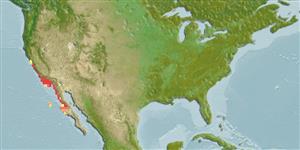Environment: milieu / climate zone / depth range / distribution range
Ecologia
marino demersale; distribuzione batimetrica 5 - 90 m (Ref. 2850). Subtropical; 11°C - 19°C (Ref. 131086); 39°N - 26°N, 124°W - 113°W
Eastern Central Pacific: San Francisco in California, USA to central Baja California, Mexico.
Size / Peso / Age
Maturity: Lm ? range ? - ? cm
Max length : 41.0 cm TL maschio/sesso non determinato; (Ref. 2850)
Occur in rocky areas, usually in crevices (Ref. 2850). Territorial (Ref. 2850). Adults feed on tiny fishes and crustaceans (Ref. 131086). Viviparous (Ref. 34817).
Life cycle and mating behavior
Maturità | Riproduzione | Deposizione | Uova | Fecundity | Larve
Eschmeyer, W.N., E.S. Herald and H. Hammann, 1983. A field guide to Pacific coast fishes of North America. Boston (MA, USA): Houghton Mifflin Company. xii+336 p. (Ref. 2850)
IUCN Red List Status (Ref. 130435: Version 2024-1)
Human uses
Pesca: commerciale; Acquario: Acquari pubblici
Strumenti
Special reports
Download XML
Fonti Internet
Estimates based on models
Preferred temperature (Ref.
123201): 10.6 - 19.4, mean 15.1 °C (based on 14 cells).
Phylogenetic diversity index (Ref.
82804): PD
50 = 0.5000 [Uniqueness, from 0.5 = low to 2.0 = high].
Bayesian length-weight: a=0.01000 (0.00495 - 0.02022), b=3.09 (2.92 - 3.26), in cm total length, based on LWR estimates for this Genus-body shape (Ref.
93245).
Trophic level (Ref.
69278): 3.7 ±0.5 se; based on size and trophs of closest relatives
Resilienza (Ref.
120179): Basso, tempo minimo di raddoppiamento della popolazione 4.5 - 14 anni (Preliminary K or Fecundity.).
Fishing Vulnerability (Ref.
59153): Low to moderate vulnerability (31 of 100).
Nutrients (Ref.
124155): Calcium = 60.8 [17.8, 190.4] mg/100g; Iron = 0.722 [0.293, 1.940] mg/100g; Protein = 18.4 [17.2, 19.6] %; Omega3 = 0.644 [0.280, 1.484] g/100g; Selenium = 56.5 [19.9, 182.1] μg/100g; VitaminA = 26.7 [8.8, 84.5] μg/100g; Zinc = 0.562 [0.281, 1.076] mg/100g (wet weight);
